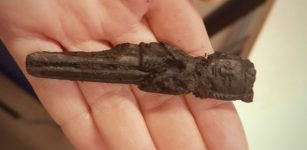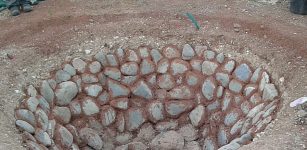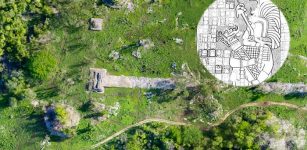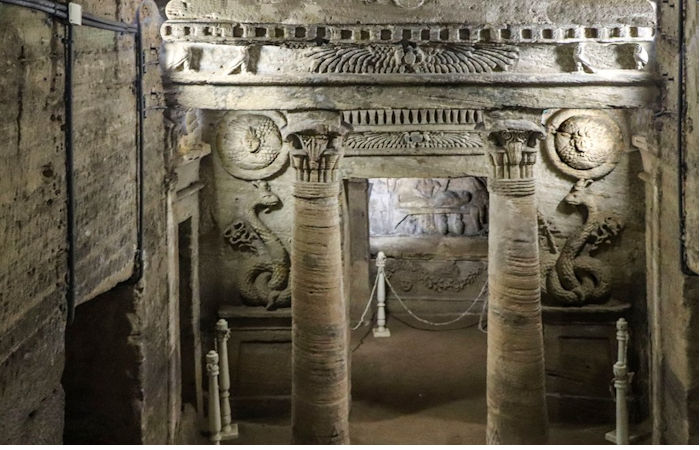Underground Catacombs Of Alexandria: Ancient Time Capsule Which Remained Hidden For Almost Two Millennia
A. Sutherland - AncientPages.com - The catacombs of Alexandria - one of the best-preserved Alexandrian complexes are the largest burial site dating back to the Greco-Roman period in Egypt.
Entrance of the principal tomb chamber. Credit: Clemens Schmillen - CC BY-SA 4.0
They are situated in the vicinity of Pompey's Pillar, a Roman triumphal column, and represent the largest of its type of construction that can be found outside of Rome and Constantinople.
The catacombs (Kom El Shuqafa, which means hill of treasures) were discovered accidentally at the beginning of the 20th century when one day, a donkey-drawn cart fell into a pit, which led to this crucial historical discovery.
The old place, dating back to the 2nd century AD, is fascinating because its architecture and decorative art have been influenced by Roman, Hellenistic, Pharaonic, and ancient Egyptian art.
The underground structure is like a time capsule, which remained hidden and undisturbed for almost two millennia.
Credit: Clemens Schmillen - CC BY-SA 4.0
The cemetery - underground tunnels dug inside the rock to a depth of 35 meters (115 feet) - consists of three levels, all located underground. Still, the lowest level of the catacombs suffered due to the flooding, which took place in the area, so it is now inaccessible.
Still, there are structures such as a spiral staircase of 99 steps, a shaft to lower the deceased's body using ropes, a dome, a banquette hall, and a vestibule with two shell-shaped niches. In one alcove to the east is a statue of a man, and to the west, there is a statue of a woman.
Decorated sarcophagus and panel with Apus-bull. Credit: Clemens Schmillen - CC BY-SA 4.0
Both statues were sculpted with the influence of Egyptian art, with some Greek features.
In the vestibule, there is an antechamber and a burial chamber with three recesses. In each of them, there is a coffin.
Other elements from mingling cultures are the winged sun disk, the Falcon God Horus, the Uraeus, or the cobra.
Central panel with Anubis mummifying a body. Credit: Clemens Schmillen - CC BY-SA 4.0
The cemetery consists of statues, human heads, Alexandrian tombs, and Pharaonic funeral cult archaeological objects strongly influenced by the Hellenistic and early Imperial Roman periods.
The catacombs were used for the last time in the 4th century AD.
Alexandria was initially established by Alexander the Great, the most famous Greek King and army leader, in 332 BC. It soon became the cultural and commercial center of the Mediterranean Sea region.
The Catacombs of Alexandria are the result of the mingling of the Greek and the Pharaonic cultures that lived side by side. At first, these were private tombs, which later became public burial places.
Written by – A. Sutherland - AncientPages.com Senior Staff Writer
Updated on February 12, 2023
Copyright © AncientPages.com All rights reserved. This material may not be published, broadcast, rewritten or redistributed in whole or part without the express written permission of AncientPages.com
Expand for referencesReferences:
Christensen w., Empire of Ancient Egypt
Johnson, P. The Civilization Of Ancient Egypt
More From Ancient Pages
-
 Puzzling Biological Event 7,000 Years Ago – Something Weird Happened To Men
Archaeology | Jun 1, 2018
Puzzling Biological Event 7,000 Years Ago – Something Weird Happened To Men
Archaeology | Jun 1, 2018 -
 Major Discovery Of 15,000-Year-Old Artifacts Could Re-Write History Of Peru
Archaeology | May 26, 2017
Major Discovery Of 15,000-Year-Old Artifacts Could Re-Write History Of Peru
Archaeology | May 26, 2017 -
 Madagascar Cave Art Hints At Ancient Connections Between Africa And Asia
Featured Stories | Dec 18, 2023
Madagascar Cave Art Hints At Ancient Connections Between Africa And Asia
Featured Stories | Dec 18, 2023 -
 New Fossil Link In Bird Evolution Discovered
Evolution | Sep 7, 2023
New Fossil Link In Bird Evolution Discovered
Evolution | Sep 7, 2023 -
 Ostrich Eggshell Beads Were Social Currency For People Who Lived 33,000 Years Ago
Archaeology | Mar 12, 2020
Ostrich Eggshell Beads Were Social Currency For People Who Lived 33,000 Years Ago
Archaeology | Mar 12, 2020 -
 Ancient City Machu Picchu Was Originally Called Huayna Picchu By The Incas – Study Of The Name Reveals
Archaeology | Mar 23, 2022
Ancient City Machu Picchu Was Originally Called Huayna Picchu By The Incas – Study Of The Name Reveals
Archaeology | Mar 23, 2022 -
 Strange Medieval Figurine With A Crown On The Head And A Falcon On The Arm – Is It A King Or A Queen?
Archaeology | Dec 16, 2021
Strange Medieval Figurine With A Crown On The Head And A Falcon On The Arm – Is It A King Or A Queen?
Archaeology | Dec 16, 2021 -
 7,000-Year-Old Native American Underwater Burial Site Discovered Off The Coast Of Florida
Archaeology | Mar 3, 2018
7,000-Year-Old Native American Underwater Burial Site Discovered Off The Coast Of Florida
Archaeology | Mar 3, 2018 -
 Early Human Settlement Unearthed In Tajikistan’s Zeravshan Valley Gives New Insights Into Human Expansion
Archaeology | Nov 5, 2024
Early Human Settlement Unearthed In Tajikistan’s Zeravshan Valley Gives New Insights Into Human Expansion
Archaeology | Nov 5, 2024 -
 Evidence Of An Ancient Roman Oracle Cult Found In Ostia, Italy
Archaeology | Jun 18, 2024
Evidence Of An Ancient Roman Oracle Cult Found In Ostia, Italy
Archaeology | Jun 18, 2024 -
 Extremely Rare 2,700-Year-Old Black Stone Seal Depicting A Winged Genie Discovered In Jerusalem
Archaeology | Sep 2, 2024
Extremely Rare 2,700-Year-Old Black Stone Seal Depicting A Winged Genie Discovered In Jerusalem
Archaeology | Sep 2, 2024 -
 Controversial Hollow Earth Theory – Startling Discoveries And Different Conclusions – Part 2
Ancient Mysteries | Jun 25, 2019
Controversial Hollow Earth Theory – Startling Discoveries And Different Conclusions – Part 2
Ancient Mysteries | Jun 25, 2019 -
 Prastio-Mesorotsos Excavations: Neolithic oven prepared food for 200 guests
News | Aug 30, 2015
Prastio-Mesorotsos Excavations: Neolithic oven prepared food for 200 guests
News | Aug 30, 2015 -
 Controversial Ancient Takenouchi Documents Could-Re-Write Our History – Story Of Gods, Lost Continents And Ancient Sages
Featured Stories | Apr 28, 2017
Controversial Ancient Takenouchi Documents Could-Re-Write Our History – Story Of Gods, Lost Continents And Ancient Sages
Featured Stories | Apr 28, 2017 -
 The 100-Kilometer-Long Stone Highway That Connected Ancient Maya Cities Revealed By LIDAR
Archaeology | Feb 25, 2020
The 100-Kilometer-Long Stone Highway That Connected Ancient Maya Cities Revealed By LIDAR
Archaeology | Feb 25, 2020 -
 Ancient City Of Timgad: Largest Roman Settlement Ever Built In North Africa
Civilizations | Feb 28, 2023
Ancient City Of Timgad: Largest Roman Settlement Ever Built In North Africa
Civilizations | Feb 28, 2023 -
 On This Day In History: Mayan King Bird Jaguar IV Assumes The Throne – On May 3, 752
News | May 3, 2016
On This Day In History: Mayan King Bird Jaguar IV Assumes The Throne – On May 3, 752
News | May 3, 2016 -
 Kantyua And Tantyua – Sacred Tibetan Books Reveal Incredible Lifespan Of The Gods
Artifacts | Mar 18, 2019
Kantyua And Tantyua – Sacred Tibetan Books Reveal Incredible Lifespan Of The Gods
Artifacts | Mar 18, 2019 -
 Puzzling Palpa Lines In Peru Made By The Paracas Culture Are Even Older Than The Nazca Lines
Featured Stories | Jan 2, 2018
Puzzling Palpa Lines In Peru Made By The Paracas Culture Are Even Older Than The Nazca Lines
Featured Stories | Jan 2, 2018 -
 British Museum Is World’s Largest Receiver Of Stolen Goods – Says QC
Archaeology | Nov 12, 2019
British Museum Is World’s Largest Receiver Of Stolen Goods – Says QC
Archaeology | Nov 12, 2019




